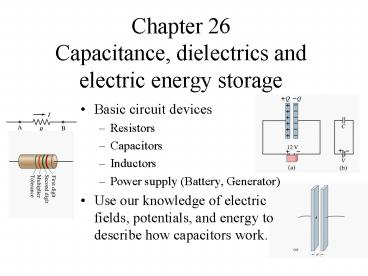Chapter 26 Capacitance, dielectrics and electric energy storage - PowerPoint PPT Presentation
1 / 33
Title:
Chapter 26 Capacitance, dielectrics and electric energy storage
Description:
Capacitance, dielectrics and electric energy storage. Basic circuit devices. Resistors ... Use our knowledge of electric fields, potentials, and energy to ... – PowerPoint PPT presentation
Number of Views:369
Avg rating:3.0/5.0
Title: Chapter 26 Capacitance, dielectrics and electric energy storage
1
Chapter 26Capacitance, dielectrics and electric
energy storage
- Basic circuit devices
- Resistors
- Capacitors
- Inductors
- Power supply (Battery, Generator)
- Use our knowledge of electric fields, potentials,
and energy to describe how capacitors work.
2
Parallel Plate Capacitor
3
Fig 26-4b, p.800
4
Active Figure 26.4
(SLIDESHOW MODE ONLY)
5
Potential difference and electric fields in a
uniform electric field
b
d
a
6
Potential difference and electric fields in a
uniform electric field
b
d
a
The constant of proportionality is called
capacitance. For a parallel plate capacitor,
the capacitance is
7
Factors affecting capacitance
- Size of the capacitor (A, d)
- Geometric arrangement
- Plates
- Cylinders
- Material between conductors
- Air
- Paper
- Wax
8
Units of capacitance
A Farad is a lot of capacitance. Typical
capacitors are micro, nano, pico-Farad
9
Capacitance Isolated Sphere
- Assume a spherical charged conductor
- Assume V 0 at infinity
- Note, this is independent of the charge and the
potential difference
10
Cylindrical capacitor
L
a
b
Q on center conducting cylinder
-Q on outer conducting cylinder
11
Capacitance of a cylindrical capacitor
L
a
b
L
12
Example
- How strong is the electric field between the
plates of a 0.80 mF air gap capacitor if they are
2.0 mm apart and each has a charge of 72 mC?
13
Capacitors in Parallel
a
b
14
Capacitors in Series
a
b
15
Capacitor circuit example
3 V
What single capacitor can replace the four shown
here? How much charge can the system hold? How
much charge is on one of the 2 mF capacitors?
16
Energy Storage in Capacitors
(Like problem 23-50)
Change in potential energy while charging
capacitor
Parallel Plates
Concentric Cylinders
In General
17
Alternate Energy Expressions
18
Energy Density
Energy per unit volume
Consider a Parallel Plate Capacitor
19
Dielectrics
- A dielectric is a nonconducting material that,
when placed between the plates of a capacitor,
increases the capacitance - Materials with Dipoles that can align with an
external electric Field. Dielectrics include
rubber, plastic, and waxed paper
-
-
-
-
-
-
K is the Dielectric Constant
Measure of the degree of dipole alignment in the
material
20
Dielectrics
21
Example values of dielectric constant
Dielectric strength is the maximum field in the
dielectric before breakdown. (a spark or flow of
charge)
22
Effect of a dielectric on capacitance
Potential difference with a dielectric is less
than the potential difference across free space
Results in a higher capacitance.
Allows more charge to be stored before breakdown
voltage.
23
Effect of the dielectric constant
Parallel Plate Capacitor
Material permittivity measures degree to which
the material permits induced dipoles to align
with an external field
Example modifications using permittivity
24
Example Parallel Plate Capacitor
Q
d
A
-Q
25
Dipoles
The combination of two equal charges of opposite
sign, Q and Q, separated by a distance l
-Q
Q
26
Dipoles in a Uniform Electric Field
Q
-Q
27
Work Rotating a Dipole in an Uniform Electric
Field
Q
-Q
28
Example P26.9
When a potential difference of 150 V is applied
to the plates of a parallel-plate capacitor, the
plates carry a surface charge density of 30.0
nC/cm2. What is the spacing between the plates?
29
Example P26.21
- Four capacitors are connected as shown in Figure
P26.21. - Find the equivalent capacitance between points a
and b. - Calculate the charge on each capacitor if ?Vab
15.0 V.
30
Example P26.27
Find the equivalent capacitance between points a
and b for the group of capacitors connected as
shown in Figure P26.27. Take C1 5.00 µF, C2
10.0 µF, and C3 2.00 µF.
31
Example P26.35
A parallel-plate capacitor is charged and then
disconnected from a battery. By what fraction
does the stored energy change (increase or
decrease) when the plate separation is doubled?
. Therefore, the
,
32
Example P26.43
Determine (a) the capacitance and (b) the maximum
potential difference that can be applied to a
Teflon-filled parallel-plate capacitor having a
plate area of 1.75 cm2 and plate separation of
0.040 0 mm.
33
Example P26.59
A parallel-plate capacitor is constructed using a
dielectric material whose dielectric constant is
3.00 and whose dielectric strength is 2.00 108
V/m. The desired capacitance is 0.250 µF, and the
capacitor must withstand a maximum potential
difference of 4 000 V. Find the minimum area of
the capacitor plates.






























